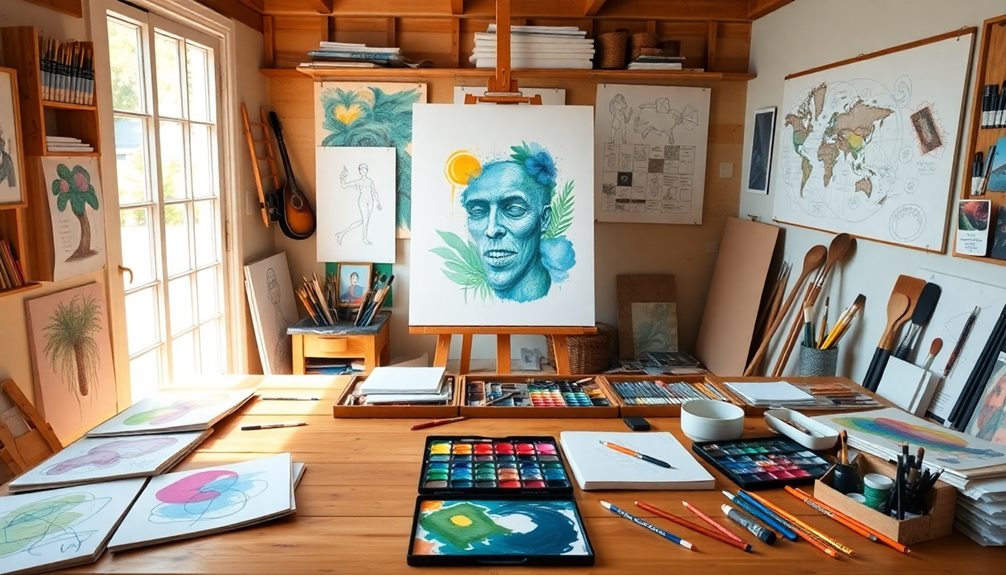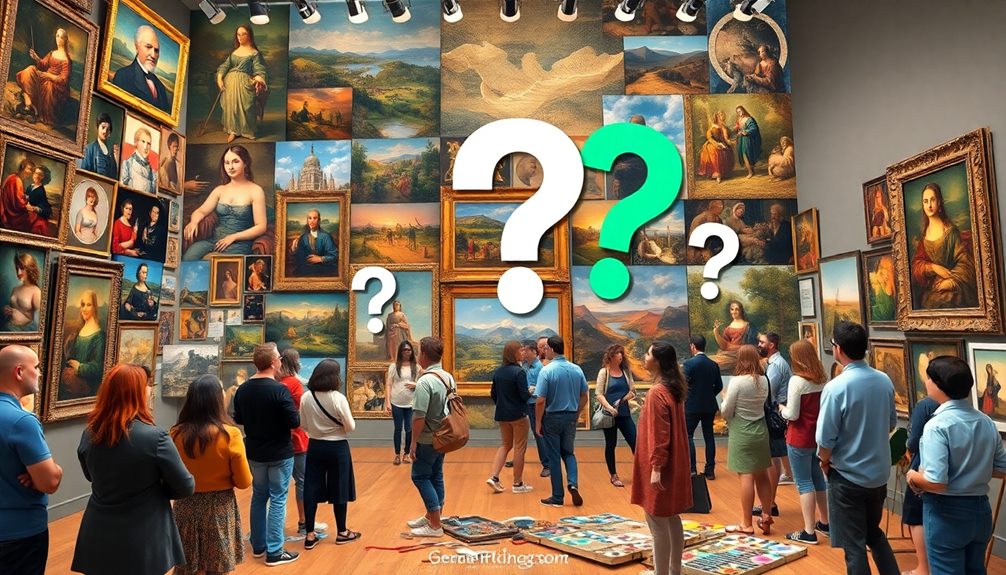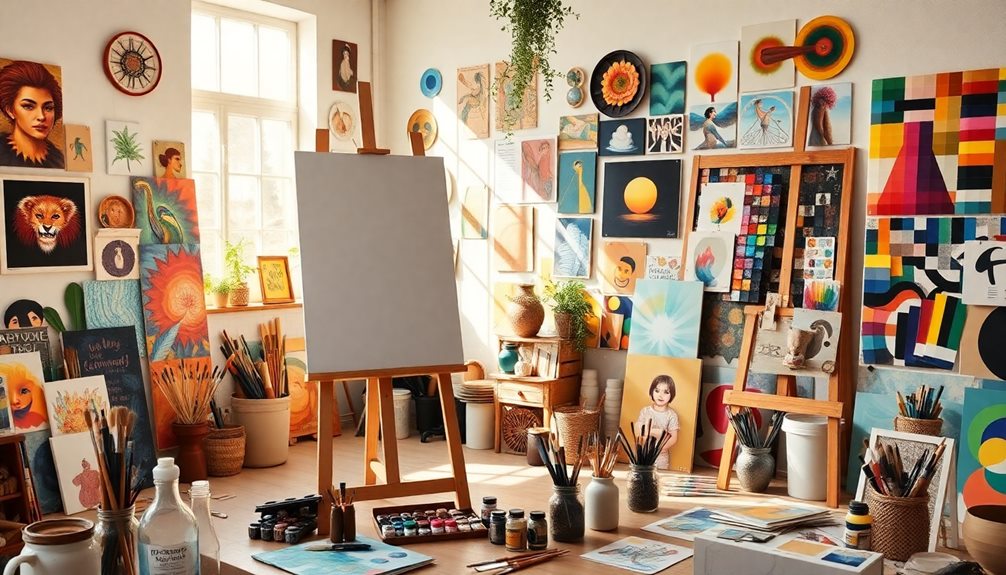A weekly art analysis exercise can really boost your observational skills and appreciation for visual art. You'll follow a structured approach, using Feldman's method: describing, analyzing, interpreting, and evaluating artworks. This practice not only enhances your understanding but also fosters critical thinking through collaborative discussions. By engaging with different perspectives and incorporating multimedia resources, you'll find the experience dynamic and enriching. Regularly analyzing art will deepen your emotional connections and historical insights. If you're curious about how to implement this exercise effectively, there's plenty more to explore that can further enhance your art appreciation journey.
Key Takeaways
- Implement Feldman's method by following the structured steps: describing, analyzing, interpreting, and evaluating artworks each week.
- Encourage collaborative discussions to explore diverse perspectives and enhance critical thinking among students during analysis exercises.
- Use multimedia resources to engage students and create emotional connections with the artworks being analyzed weekly.
- Incorporate self-assessments and peer feedback to promote reflective learning and improve observational skills in art analysis.
- Allocate time for practical exercises to solidify understanding of visual elements and foster innovative thinking in art education.
Introduction

The weekly art analysis exercise serves as a valuable tool for enhancing your observational skills and understanding of various artworks. Through this structured critique and discussion, you and your peers can deepen your appreciation for art in ways that traditional art lessons may not provide.
By applying Feldman's method of art criticism—describing, analyzing, interpreting, and evaluating—you'll engage with each piece more thoughtfully. This approach not only encourages innovation through understanding historical context but also highlights the role of intuition and emotion in art creation, as seen in art practice versus theory.
In these exercises, you'll collaborate with fellow students, exchanging diverse perspectives that promote critical thinking. Each discussion opens the door to new insights, allowing you to compare different artworks and their historical contexts. This collaborative environment not only enriches your learning experience but also builds a sense of community among students.
Incorporating multimedia resources like videos and interactive content keeps the exercises dynamic and engaging. Regular participation in these sessions helps you improve your art vocabulary and fosters a lifelong appreciation for visual arts.
As you delve into the nuances of each artwork, you'll find your observational skills sharpen and your understanding of art education deepened, laying a solid foundation for your future explorations in the art world.
Key Concepts and Definitions

In exploring key concepts and definitions of art analysis, you'll encounter essential elements that form the foundation of your understanding. Art analysis involves a detailed examination of artworks, enhancing your appreciation for visual elements like color, line, shape, texture, and space.
As students learning this process, you'll engage in multiple steps: describing, analyzing, interpreting, and evaluating artworks. This structured approach fosters critical observation before forming judgments. Additionally, tapping into the power of imagination can lead to transformative insights during your analysis, allowing you to explore new interpretations and meanings.
One effective method is comparative analysis, using tools like Venn diagrams to identify similarities and differences between artworks. This not only enriches your analytical skills but also promotes deeper insights.
Additionally, collaborative discussions and guided questions are vital techniques art teachers use to encourage diverse perspectives, leading to a more engaging critique experience.
Incorporating historical context and thematic exploration further enhances your analysis. This allows for a nuanced interpretation of the artist's intent and the artwork's significance.
Understanding these key concepts equips you with the tools needed for thoughtful art analysis, transforming how you engage with and appreciate art in all its forms.
Art Analysis Framework Essentials

Understanding the art analysis framework is crucial for anyone looking to deepen their engagement with art. This framework, including methods like Feldman's, guides you through stages of description, analysis, interpretation, and evaluation. By following these structured methodologies, you can develop a thorough understanding of artworks before passing judgment.
Incorporating techniques similar to those in AI-driven personalization in E-learning can further enhance the learning experience by tailoring approaches to individual student needs.
In art classes, using this framework can help students really look at pieces critically. Collaborative discussions and guided questions encourage deeper thinking about the art, promoting engagement among peers. Practical exercises, such as creating descriptive word lists or comparing artworks with Venn diagrams, enhance observational and analytical skills in a hands-on way.
Integrating technology, like digital portfolios and interactive apps, can make art analysis more accessible and engaging. These tools allow for innovative approaches that resonate with today's learners.
Additionally, assessing art analysis skills through self-assessments, peer feedback, and rubric-based evaluations fosters accountability and growth in students' understanding.
Art Critique Group Discussion
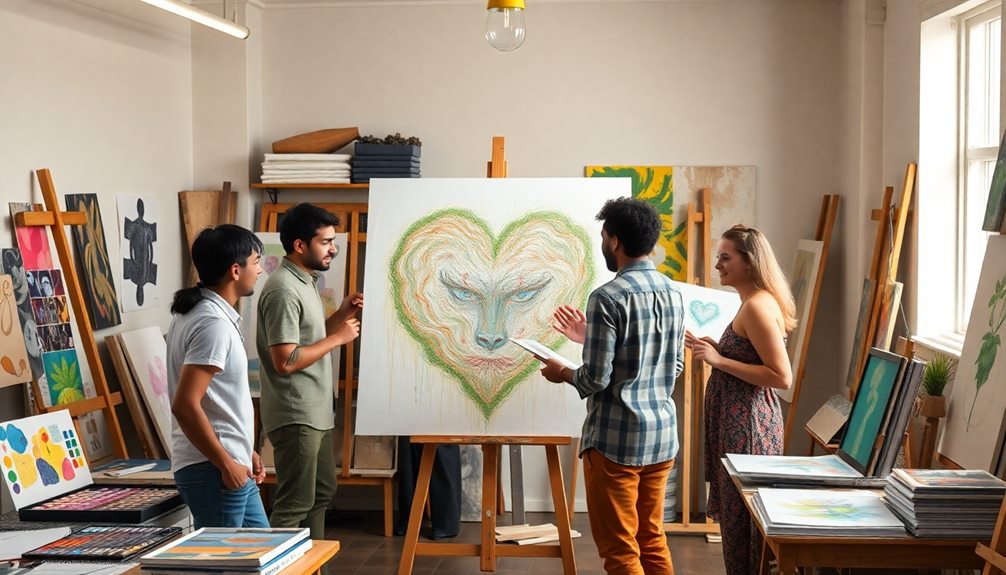
Engaging in art critique group discussions offers students a dynamic platform to voice their interpretations and insights. In these collaborative settings, students see the value of sharing diverse perspectives, which deepens their understanding and appreciation of various artworks.
By implementing structured frameworks, such as the Elements of Art, you can guide critiques and provide a clear method for evaluating visual elements effectively.
Utilizing guided questions during discussions stimulates critical thinking, encouraging you to dig deeper into your interpretations. This approach not only enhances your analytical skills but also fosters a supportive environment where peer feedback is essential.
Students learn to articulate constructive criticism, which is invaluable for personal growth in artistic endeavors.
Incorporating multimedia resources, like videos and digital galleries, makes the art critique experience even richer. These free resources can spark more engaging and informative discussions, helping you and your peers connect with the artwork on multiple levels.
Tips and Best Practices

When it comes to art analysis, embracing a structured approach can significantly enhance your learning experience. Start by implementing frameworks like Feldman's method, which guides you through description, analysis, interpretation, and evaluation. This method helps you build a comprehensive understanding of artworks step-by-step.
Encourage collaborative discussions in your classroom. These discussions foster diverse perspectives and enhance critical thinking skills. When students write critiques together, they share insights that deepen everyone's understanding.
Use guided questions during these critiques to stimulate reflection, prompting you to explore the emotional and contextual elements of the art.
Incorporate multimedia resources such as videos and interactive content. These tools can enrich your learning experience and help you connect with artworks on a personal level.
Student Engagement and Feedback
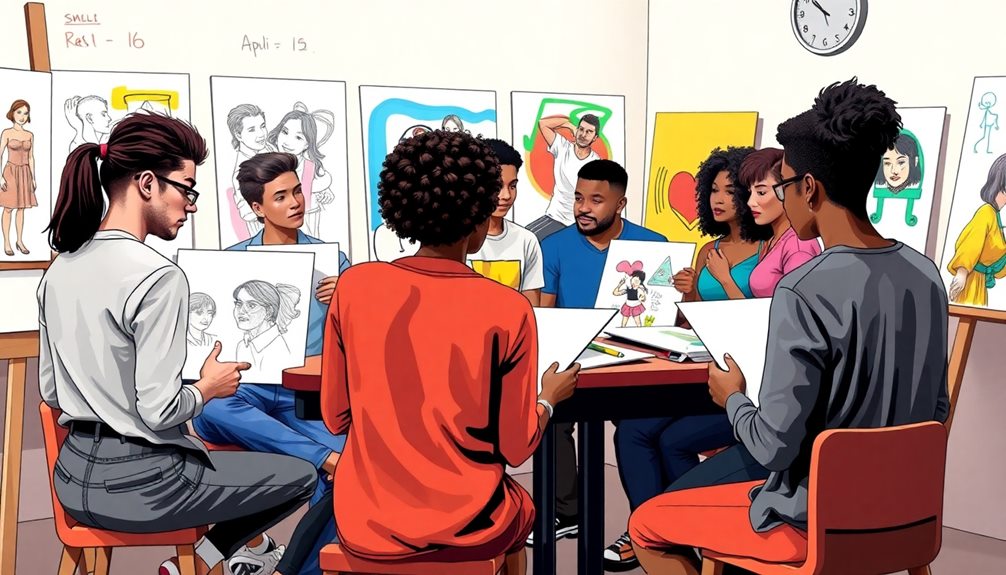
Art critique isn't just about analyzing works; it's also about how students interact with each other and the feedback they receive. Engaging students through collaborative discussions fosters diverse perspectives and enhances critical thinking skills. Using structured frameworks like the Elements of Art, you can guide these discussions effectively.
Implementing varied feedback methods, such as peer assessments and reflective activities, significantly boosts student engagement. Activities like "2 Stars 1 Wish" encourage you to identify strengths and areas for improvement in your classmates' work, creating a supportive learning environment. This approach not only helps you give constructive feedback but also helps you learn from others.
Incorporating multimedia resources and interactive content into art analysis enriches your learning experience. This keeps you motivated and actively involved in the critique process.
Additionally, providing opportunities for self-assessment—like emoji reflections or structured criteria evaluations—fosters your meta-cognitive awareness and autonomy in learning.
Ultimately, effective student engagement and feedback in art critique deepen your understanding and appreciation of art, making the entire process more rewarding and enjoyable.
Time Constraints in Classes

Navigating time constraints in art classes can be tricky, often forcing you to rush through exercises that deserve more attention. Typically, daily warm-ups only allow 5-10 minutes for each exercise, which limits your ability to engage in meaningful analysis or critique. While this structured routine helps you practice quickly, it doesn't always foster a deep understanding of your work or the techniques involved.
Art criticism methods, like Feldman's approach, require several days for a thorough grasp, which can be tough to fit into standard class time. As a student, you might feel the pressure to prioritize certain skills over others due to these limitations.
Effective classroom management strategies are crucial in maximizing your time during lessons, as distractions can further compress your available minutes for art analysis. You often find yourself balancing the need for detailed critique with the practicalities of the clock.
This can lead to a focus on quick assessments rather than thoughtful exploration. Ultimately, while time constraints challenge your learning experience, they also push you to be more efficient and focused in your artistic endeavors. Embracing this challenge can lead to growth in your skills over time.
Additional Resources
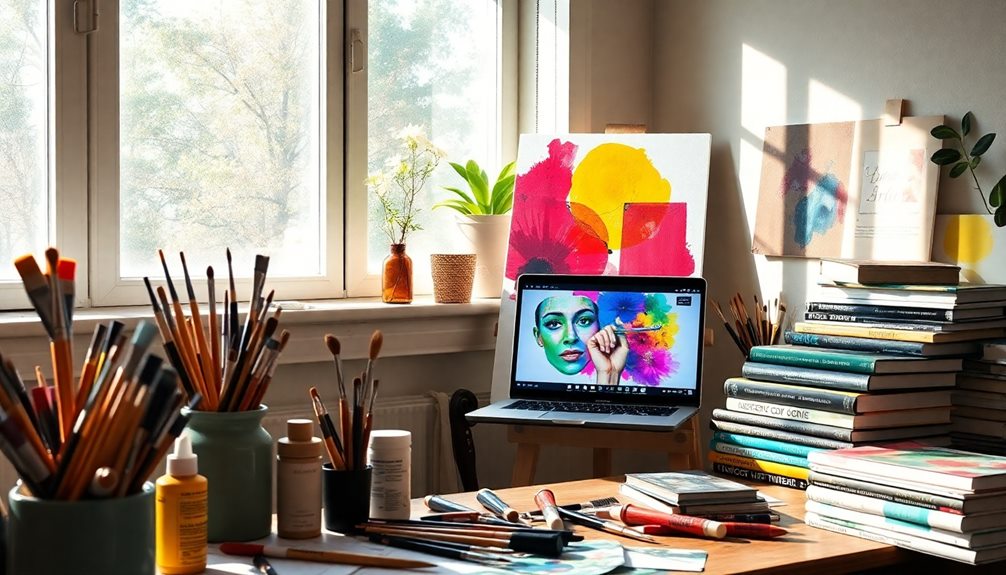
To enhance your understanding of art analysis, a variety of additional resources are at your fingertips. Free downloadable templates and guides can help you implement art analysis exercises effectively. These tools simplify complex concepts and provide structured approaches, making it easier for you to grasp artistic techniques.
Online platforms offer tutorials and classes designed to boost your analytical skills. When students take the time to explore these resources, they often discover fresh ideas for art that inspire deeper engagement with artworks. Additionally, recommended tools for techniques like linocut and sculpture provide hands-on experiences that can complement your theoretical understanding.
Don't underestimate the value of community resources. Local art workshops and networking opportunities not only foster collaboration but also enhance skill development. Many students find that such environments enrich their art education significantly.
Educators have reported positive feedback on shared resources for art analysis, indicating a high demand for innovative teaching methods. By tapping into these additional resources, you're not just improving your skills; you're also joining a community dedicated to exploring and appreciating art more profoundly.
Frequently Asked Questions
How Do I Choose the Right Artwork for Analysis?
Choosing the right artwork for analysis involves considering your interests, the piece's emotional impact, and its historical significance. Focus on artworks that resonate with you personally, as this will enhance your engagement and understanding during analysis.
Can I Analyze Digital Art Using This Framework?
Yes, you can absolutely analyze digital art using this framework. Just focus on elements like composition, color, and theme. It'll help you appreciate the unique qualities of digital pieces, enhancing your overall understanding of art.
What if My Group Disagrees on the Artwork's Meaning?
If your group disagrees on the artwork's meaning, embrace the discussion. Encourage everyone to share their perspectives, as differing interpretations can deepen understanding. Listen actively and find common ground to enrich your analysis together.
Are There Any Specific Art Movements to Focus On?
Absolutely, you can focus on movements like Impressionism, Surrealism, or Abstract Expressionism. Each offers unique perspectives and techniques. Exploring these will deepen your understanding and appreciation of how artists communicate their ideas and emotions.
How Can I Improve My Art Analysis Skills Over Time?
To improve your art analysis skills, regularly practice observing artworks, read critiques, engage in discussions, and seek feedback. Don't hesitate to explore different styles and techniques; each experience will deepen your understanding and appreciation.
Conclusion
In wrapping up your weekly art analysis exercise, remember that exploring art deepens your understanding and appreciation. Embrace the key concepts and frameworks we've discussed, and don't shy away from sharing your thoughts in group discussions. Engaging with your peers can spark new insights and inspire creativity. Keep these tips in mind, and always seek feedback to enhance your skills. With practice, you'll sharpen your analytical eye and enjoy the journey of art even more!
